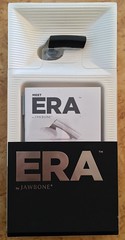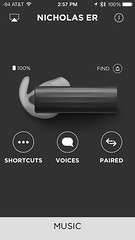Friday, 31 January 2014
ERA by Jawbone (2014)
Last May I posted a comparison between the Jawbone ERA and the BlueAnt Q3, with an emphasis on my primary use case of podcast listening. The final outcome of this was a bit anticlimactic: I managed to lose the Q3 during a trip and my ERA stopped misbehaving so I went back to it.

A few weeks ago, Jawbone introduced a new ERA, confusingly named “ERA by Jawbone”. Once again, iLounge has a review of the new device, which is worth reading as background before you dive into the following.
Externally the new ERA looks much the same as the old one, just smaller, lighter and thinner. I didn’t buy a version with the charging case (partially because Amazon doesn’t stock the black case) so I can’t opine on it, but I’ve used other-brand headsets with charging cases and found them useful. The device now plugs in to charge straight rather than at an angle, which might look a little less elegant (the headset curve no longer matches the curve on the USB cable) but is a lot more discoverable. The bundled charging cable is slightly shorter, but this may just be manufacturing variation. There’s no AC adapter (the old one wasn’t particularly compact, in any case) or carrying pouch included. The packaging, at least as ordered from Amazon, is refreshingly simple and easy to remove.
The new ERA has shorter battery life but no apparent change to the headset’s excellent range. I am able to listen glitch-free two rooms away from my iPhone, a feat unequalled by the other headsets I’ve used recently (the BlueAnt Q3 and JF3 Freedom). The range depends as much on the device on the other end — if I transmit from my Mac mini rather than my iPhone, I can’t even make it one room away without audible dropouts. So you’re seeing poor performance from your computer’s internal Bluetooth, you might consider a USB Bluetooth adapter.
Protocol-wise, the new ERA supports Bluetooth Smart (4.0) with HFP 1.6, A2DP 1.2, AVRCP 1.4, HSP 1.2 and SPP, according to the Web site. The previous ERA, introduced about 3 years ago in January 2011, implemented Bluetooth 3.0 (at least HFP, HSP and A2DP).
On to my complaints about the original ERA, with updates inline:
There’s no audible feedback for the first few seconds when turning on the headset. Startup is slow — total time from power on to pairing with an iPhone 4S is about 5 seconds.
I must have made a mistake in my previous post. As I just tested it, the old ERA takes ~4 seconds from power on to any audio feedback, and 9 seconds from power on to pairing with an iPhone 5s. The new ERA takes ~3 seconds to audio feedback (which doesn’t sound like a ripoff Mac startup sound any more) and another second to pair. Regardless, this is a substantial improvement — slightly slower than the Q3 but acceptable, given it takes a second or two just to attach the headset to my ear.
Volume control requires you to hold down the button while audio is playing (otherwise, it triggers Siri, the way I have it configured), and inevitably causes me to overcorrect and/or trigger Siri. It’s hard to figure out whether the volume is increasing or decreasing, as it alternates after it “bounces” off the extrema.
Volume control on the headset itself still works the same way, but is now synchronized with the host device’s volume, so for example, you’ll see the volume change on the iPhone screen while you adjust it on the headset, or you can use the volume controls on the iPhone itself. You’ll sometimes see the volume bezel pop up on an iOS device when the device connects. The Q3 still does this better.
Related to the above: triggering Siri requires holding down the button, hearing 2 beeps from the headset, then waiting a while before hearing Siri’s acknowledgement.
No change, but I’m pretty used to it by now. iOS 7 seems less willing to activate Siri at all when the phone is locked, so unless I’m actively using the phone I end up having to pull it out of my pocket anyway.
You’re supposed to be able to trigger various actions by tapping or shaking the headset. These never worked reliably for me.
These features (and, I imagine, the associated accelerometer) have been removed entirely from the new ERA.
I have to carry around two earbuds: one is comfortable to wear for hours when listening to audio, but it puts the headset so far away from my mouth that the phone call quality — or, more relevantly for me, Siri — is essentially unusable. The other earbud I use for phone calls, very infrequently. There’s also an ear hook, but it does not attach securely and has been awkward to the point of uselessness in my experience.
The new ERA includes only one style of earbuds, in several sizes, and no ear hook (loop). There is an alignment bulge on the headset which prevents the earbud from getting out of alignment. The good news is that for ease of placement, comfort, and generally staying attached to my ear and adjacent to my cheek while I move around, the new design is the best I’ve ever used on any headset. Siri works reliably and I used it for FaceTime earlier today without a hitch. The bad news is that there’s no in-ear-canal earbud option at the moment, and the alignment bulge precludes compatibility with the original ERA’s earbuds. More about this at the end.
My other complaints were intermittent issues, which I can’t evaluate yet as I’ve had the new headset for less than a day.
New features on the 2014 ERA

As with the Q3, the new ERA can be simultaneously connected to two devices. This is opportunistic for both devices — typically it connects to the second device a few seconds after the first. The implementation is seamless. With both my iPhone and iPad connected, when I tap the play button on either device, it starts playing on that device and pauses the other device instantly. However, one time I tried this, it caused the audio to stutter on the newly-playing device until I tapped pause and play again. After restarting the headset, it was fine.
Bluetooth configuration and control may now be performed from an iOS (or Android) app, in addition to the previously-supplied Web app (which uses a companion Mac/Windows app to interface with the device). This includes:
- Numerical display of battery percentage (though not time remaining as on the device itself, oddly enough).
- Mapping a button press-and-hold to Siri or a “speed dial” for a contact of your choice. On a call, you can choose between cycling the volume or muting the microphone.
- Selecting from one of several sets of voice samples, though the iOS app’s previews have yet to be completely updated (e.g., they still include the prior ERA’s startup sound).
- Triggering a “Find” function. These headsets are small, to the point they often live in the coin pocket of my jeans, and the new one is quite a bit smaller. I seem to lose my headset at home every week or two while it’s turned on, so this is a feature I’d use frequently. It is thoughtfully implemented, first warning you via voice that you’ll be deafened in case you have the headset in your ear, then playing a tone with increasing volume.
- Enabling or disabling simultaneous connections. You can also view connected devices here and (slowly) trigger a connection attempt to the other device.
- Remote controlled playback (via AVRCP): tap the button 3 times to play and once to pause. You can’t change tracks, but particularly given the steps back in lock-screen audio control in iOS 7, this is appreciated.
Some configuration is still limited to the Web/native app:
- Renaming the headset
- Updating firmware (there was an update available today provided without release notes, which at least fixed a small volume adjustment issue I noted; all my tests were with the upgraded firmware)
- Removing device pairings
- Configuring caller ID by name for up to 20 contacts, either by manually entering names and numbers or importing from Google Contacts; unlike the Q3, the new ERA doesn’t support PBAP for direct transfer of names from a phone’s address book
What about SPP? My guess is that it’s used for configuration: if I connect to the serial port from the Mac, I can get it to spit out “unknown command” but that’s about it.
As is often the case with device manufacturers, neither the Web nor iOS software for managing the device is terribly reliable or easy to use. Just in the first day, I ran into layout issues with the Web app where the entire UI was invisible (white on white), a hang on quit in the Mac app, device name truncation and a repeated failure to connect from the iOS app. Switching between devices in the iOS app is also pretty confusing, as there are two ways to select devices: the AirPlay icon (which only shows devices that are connected), and the “J”-in-a-circle button, which also shows devices that are available, regardless of whether they’re connected. If you tap on an disconnected device here, you are given “Connect” and ”Find” buttons, but tap on an already-connected device and nothing happens.
The earbud situation
The earbud situation is unfortunately a show-stopper for me at the moment. None of the supplied earbuds fit in your ear canal. With the supplied earbuds, the new ERA is fine if you’re in a quiet room, but inaudible if you’re walking on the sidewalk next to light traffic, or as I was this evening, doing laundry. A couple of washing machines running nearby are enough to make me strain to hear, in comparison with the old ERA with an in-canal earbud. If I take off the supplied earbud, the plastic inner piece does fit in my ear canal, but it’s none too comfortable.
The headset is obviously brand new at this point and even replacements for the existing earbuds are not yet available, despite references in the documentation. Jawbone offers three distinctly different earbud styles for the ERA (“type C”, “round” — the in-canal type — and “spout”) as well as for their previous headsets, so I am relatively hopeful that there will be similar options for the new ERA in the next few weeks to months.
 7:14 PM
7:14 PM
[…] Nicholas Riley: […]
[…] music player. It’s waterproof and will eventually be programmable. Given my prior interest in Bluetooth headsets you may guess I was a backer, and you’d be […]